More than 50,000 Japanese flee homes after powerful earthquakes trigger tsunami
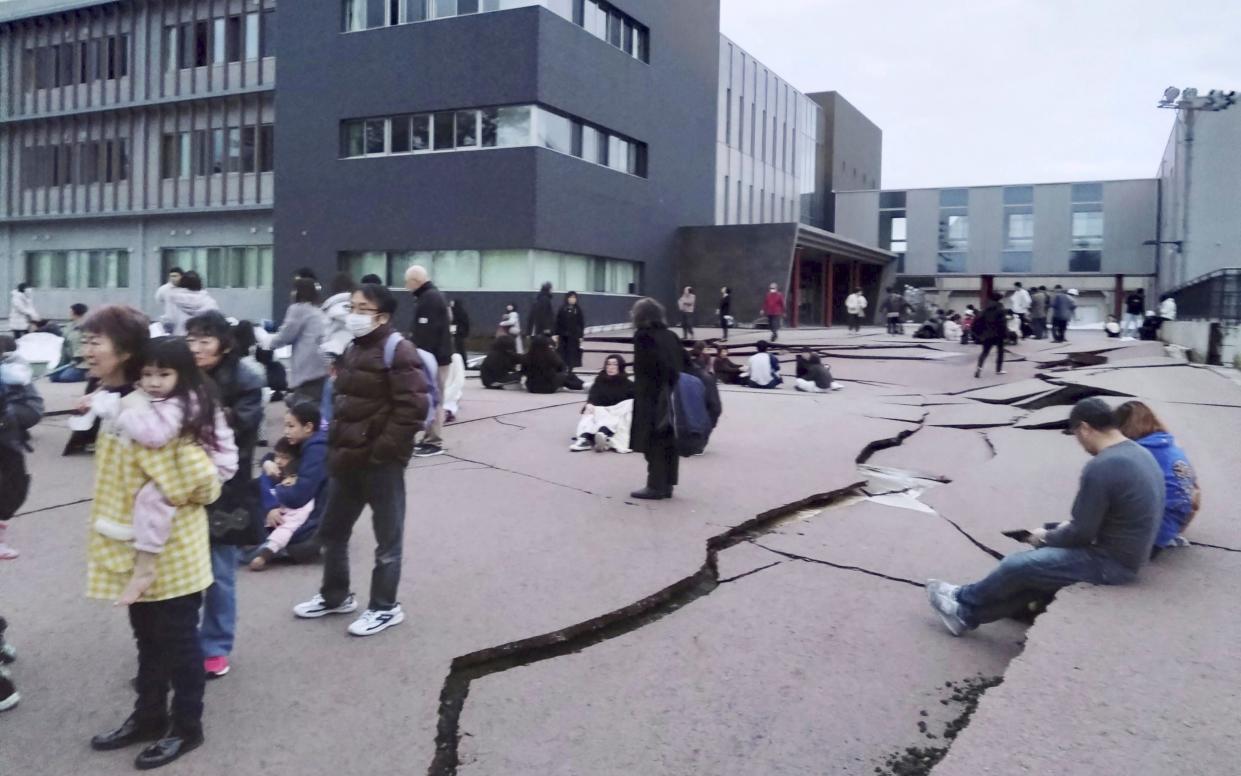
- Oops!Something went wrong.Please try again later.
More than 50,000 people were forced to flee their homes in Japan after a series of powerful earthquakes triggered the country’s first major tsunami warning since the 2011 Fukushima disaster.
Thirty people were reported by Japanese authorities to have died and many others were buried alive under rubble in what was the country’s strongest earthquake in nearly a decade.
The largest 7.6 magnitude tremor brought one-metre high waves crashing on to the western coast of Honshu, the east Asian country’s main island, shortly after 4pm local time (7am GMT).
It was followed by aftershocks and fears of larger tsunamis to come. Warnings were also issued on the eastern coasts of North and South Korea and in Russia’s far east.
The quakes struck the country on New Year’s Day, one of Japan’s most auspicious public holidays.
Japan remains haunted by the memory of the 9.0 magnitude Tohoku earthquake in March 2011 which triggered a tsunami that left nearly 20,000 people dead or missing and led to a meltdown at the Fukushima nuclear plant.
South Korea’s Gangwon province, North Korea’s entire east coast and the far-eastern Russian regions of Sakhalin, Khabarovsk and Primorsky also issued tsunami warnings.
The waves expected to make landfall in those countries were predicted to be smaller and pose a less significant threat to life than in Japan.
At the tremors’ epicentre on Honshu’s Noto peninsula, buildings were filmed falling down in the city of Suzu and roads were splintered in Wajima, a city 27 miles to the west, where at least 30 buildings collapsed.
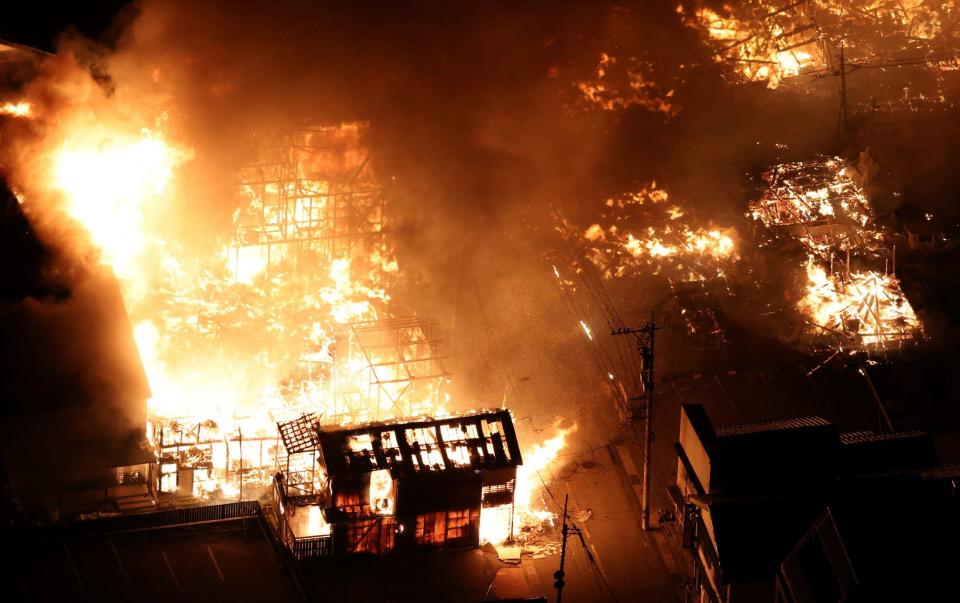
One elderly man was pronounced dead at the scene of a building collapse in the town of Shika, broadcaster NTV reported police as saying.
In Kanazawa, the regional capital, video footage showed frightened shoppers watching on as products fell off shelves.
To the north in the coastal town of Uchinada, roads lay mangled from the force of the quakes and 90 miles east, in Nagano, tremors shook snow from the roofs of houses.
Temperatures were expected to drop to just above freezing overnight and 36,000 homes were cut off from power.
Fumio Kishida, Japan’s prime minister, urged authorities to prioritise “human life above all else” and “spare no effort in our emergency disaster responses”.
“The search and rescue of those impacted by the quake is a battle against time,” Mr Kishida said during an emergency disaster meeting on Tuesday.
Mr Kishida said rescuers were finding it very difficult to reach the northern tip of the Noto peninsula due to wrecked roads, and that helicopter surveys had discovered many fires and widespread damage to buildings and infrastructure.
Rishi Sunak said Britain stands “ready to support Japan”.
The Prime Minister said: “My thoughts are with all those affected by the earthquakes in Japan which have caused such terrible damage. Prime minister Fumio Kishida is a great friend of the UK and we stand ready to support Japan and are monitoring developments closely.”
The initial major tsunami warning, which warns of five-metre waves, was later downgraded to a standard tsunami warning – meaning three-metre waves could occur – and then to a tsunami advisory, which forecasts one-metre waves.
These remain in place for the entire 1,650-mile length of Japan’s western coast, from Kyushu in the south to Wakkanai in the far north of Hokkaido.
Evacuated locals have been urged by authorities not to return as aftershocks and smaller tsunamis are expected to continue for several days.
High risk of buildings collapsing
“There is a very high risk of buildings collapsing and other damages caused by the tremors,” a spokesman for the Japan Meteorological Agency (JMA) said.
The series of tremors on the Noto peninsula started shortly after 3pm local time (6am GMT).
The strongest of more than 150 quakes that followed was at a magnitude of 7.6 and struck at 4.10pm local time (7.10am GMT), the JMA said.
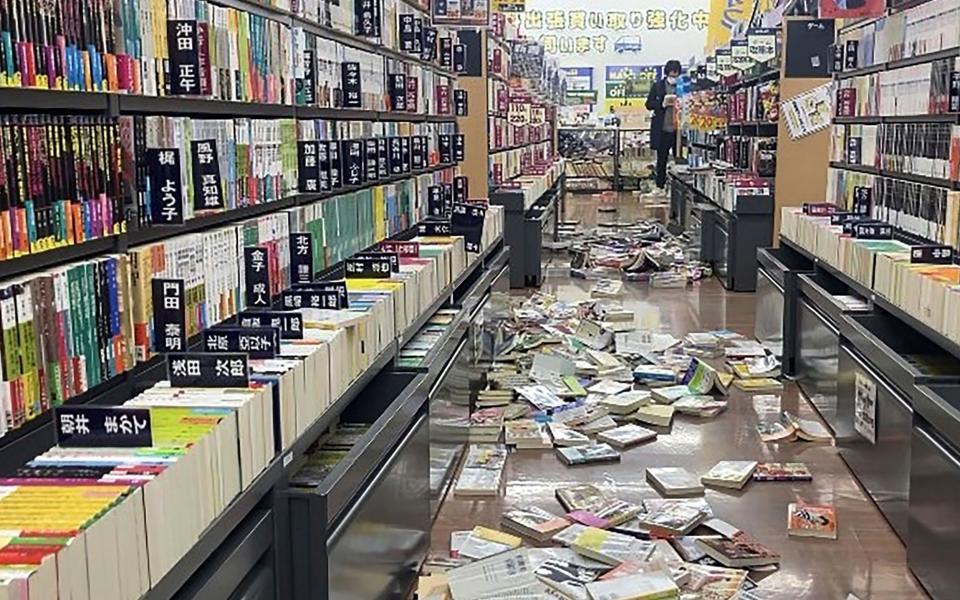
Flights to the region were cancelled by Nippon Airways and Japan Airlines and 40 train lines were suspended as passengers filmed their carriages shaking in the tremors.
Shocks triggered by the earthquake were felt as far away as Tokyo, nearly 200 miles away.
Mobile phone and internet services were also disrupted in the Ishikawa and Niigata regions, but all nuclear power plants along the Sea of Japan were unaffected.
Tsunami waves more than one metre high hit the port city of Wajima on the peninsula shortly after and aftershocks and smaller tsunamis have continued ever since.
Tsunamis can take several days to dissipate
Professor Kenji Satake, of the University of Tokyo, told NHK that tsunamis in the region “bounce back” off the coastline, meaning the energy within them can take several days to dissipate.
Ishikawa prefecture, the worst-affected region, is a relatively rural part of Japan with a total population of 1.1 million.
Beyond the historic city of Kanazawa, its capital, coastal communities are typically small and rely on fishing and tourism.
New year is the most important public holiday in Japan and most businesses close for the first three days of the year.
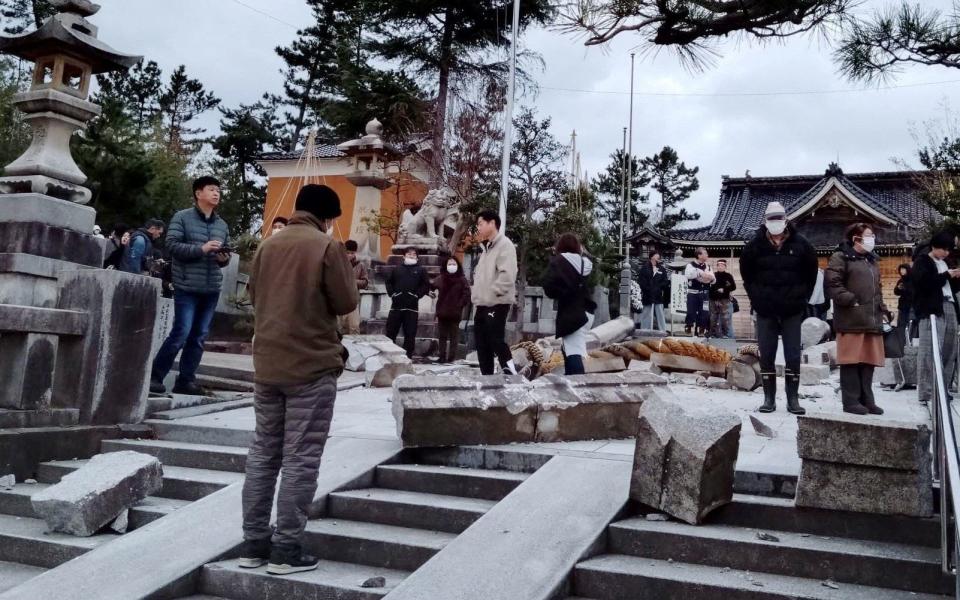
Families gather to spend time together, send new year cards and visit Shinto shrines or Buddhist temples.
Sunday’s quake was Japan’s strongest since May 2015 when the 7.8 magnitude Ogasawara earthquake struck more than 500 miles south of the mainland.
There are hundreds of earthquakes in the country every year and most cause little or no damage.
04:54 PM GMT
That's all for today
Our live coverage is now concluding. Thank you for following.
04:53 PM GMT
Pictured: Evacuees spend night in government office
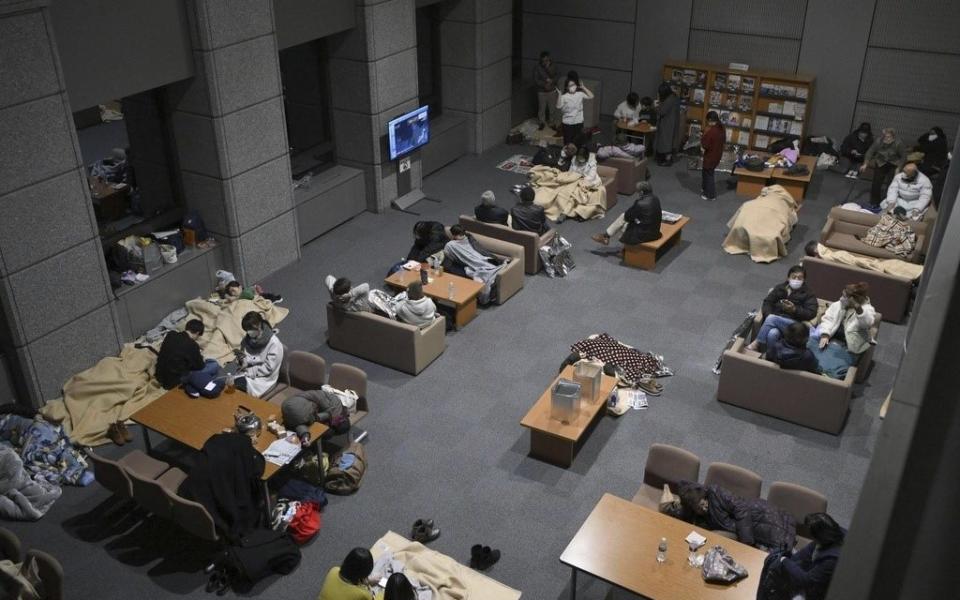
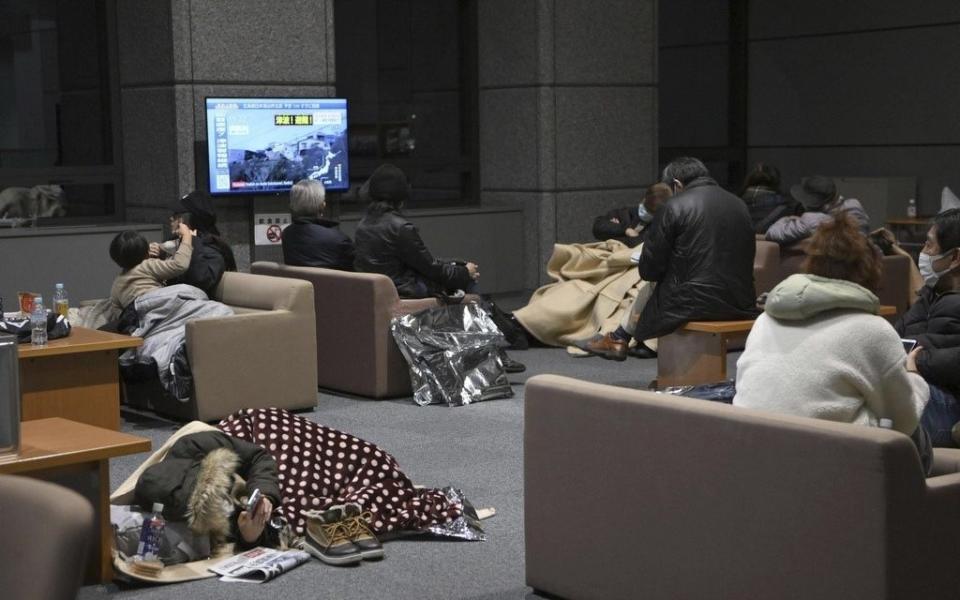
04:42 PM GMT
All tsunami warnings downgraded
Every tsunami warning has been downgraded to an “advisory”, the Japan Meteorological Agency (JMA) has said.
The 1,650-mile length of Japan’s western coast from Kyushu in the south to Wakkanai in the far north of Hokkaido was previously under a tsunami warning”, meaning there was a risk of three-metre waves.
That has now been downgraded to a “tsunami advisory”, meaning waves are expected to reach a height of one metre.
04:12 PM GMT
Watch: Landslide in Kanazawa city
Video footage has emerged from the city of Kanazawa, the capital of the worst-affected Ishikawa prefecture, showing a landslide that has carried away cars and large portions of a road.
Here is another video of the damage inflicted by today's earthquake in Japan. The uploader labeled it as a video of Kanazawa: pic.twitter.com/beCcqJiuHH
— Jeffrey J. Hall 🇯🇵🇺🇸 (@mrjeffu) January 1, 2024
03:58 PM GMT
Quakes came on Japan's most important public holiday
New year’s day is Japan’s most important and auspicious public holiday.
Most businesses close for the first three days of the year and on January 1 families gather to spend time together, send new year cards and visit Shinto shrines or Buddhist temples.
What happens on new year’s day is also believed to set the tone for the rest of one’s year, meaning the timing of Sunday’s earthquakes was particularly unfortunate.
03:49 PM GMT
Map: The areas affected
03:27 PM GMT
Airport cancels all flights
An airport on the Noto peninsula in Ishikawa where the earthquakes have struck has cancelled all flights that were due to take off on Monday.
In a statement on X, Noto Airport said: “It has been decided that all flights from Noto Airport tomorrow will be cancelled.
“Everyone living in Noto, please stay safe.”
03:14 PM GMT
Watch: Ski lifts shake in Japan as earthquakes strike
03:01 PM GMT
Pictured: Road severed in Nanao, Ishikawa
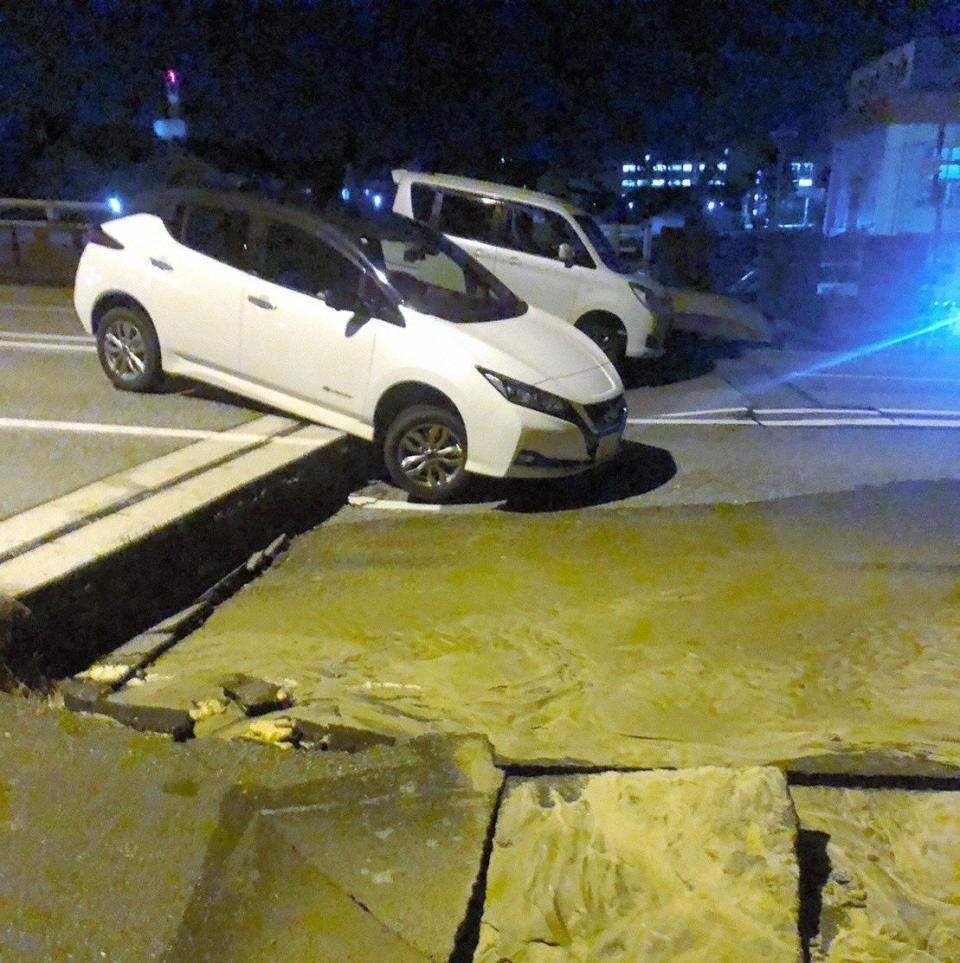
02:35 PM GMT
More than 80 earthquakes today
There have been more than 80 earthquakes recorded by the Japan Meteorological Agency (JPA today).
The quakes have been near-continuous and range in magnitude from 3 to 7.6.
01:55 PM GMT
Do not return home, authorities warn
Japan’s Meteorological Agency (JPA) has warned residents not to return home because tsunamis are still being recorded off the western coast of the country’s main Honshu island.
Evacuation orders remain in place.
01:27 PM GMT
Two confirmed dead
Two people have been confirmed dead in Japan after the earthquakes, state broadcaster NHK has reported.
The circumstances of their deaths were not disclosed.
A number of others remain trapped under collapsed buildings.
12:57 PM GMT
'Very high' risk of building collapse for three days
Buildings in affected areas of Japan will remain at a “very high risk” of collapsing for a further two to three days, a spokesman for the Japan Meteorological Agency has said.
“There is a very high risk of buildings collapsing and other damages caused by the tremors,” he said.
“History tells us that the similar scale of earthquakes can reoccur within two to three days.”
12:25 PM GMT
More than 50,000 Japanese told to leave homes
More than 50,000 Japanese people have been told to leave their homes, national broadcaster NHK has reported.
The 51,000 civilians are spread across five different prefectures.
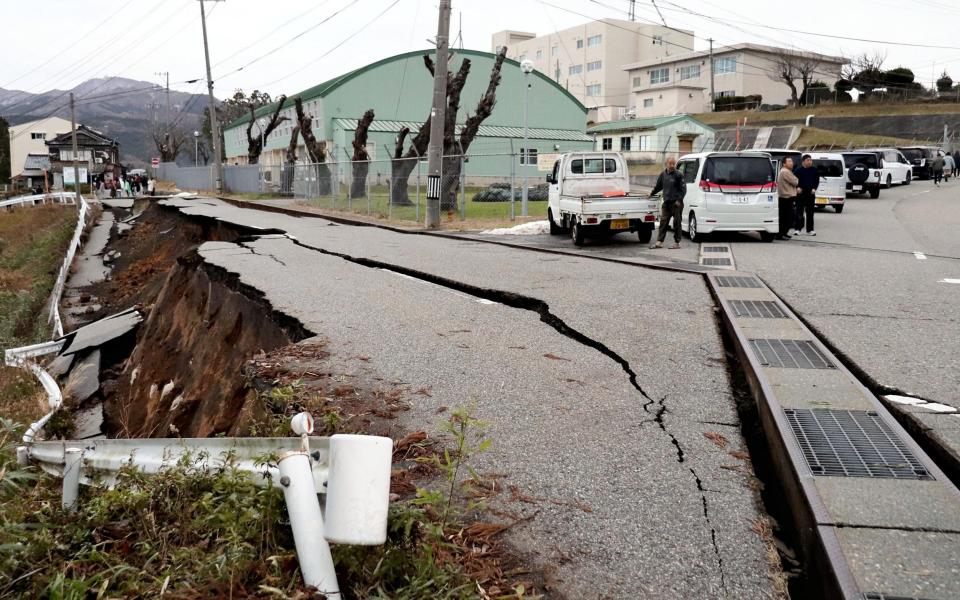
12:12 PM GMT
At least 30 buildings collapse in one city
At least 30 buildings have collapsed in the city of Wajima in Ishikawa, the city’s fire department has said.
Ishikawa is the prefecture which has been most affected by the earthquakes.
12:01 PM GMT
Tsunami waves could take days to abate, says expert
A Japanese ysunami expert has warned that it may take as long as several days before the waves triggered by the earthquake abate as the tremor occurred within the relatively constrained waters of the Sea of Japan, Julian Ryall reports.
Professor Kenji Satake, of the University of Tokyo, told national broadcaster NHK that historically, tsunami in the Sea of Japan can “bounce back” off a coastline and go in a different direction.
The energy within the waves can therefore take several days to dissipate, he explained.
The Sea of Japan is encircled by the landmasses of Japan, the Korean peninsula and Russia.
There are relatively narrow outlets into the Pacific Ocean to the far north and south.
11:47 AM GMT
Japan downgrades tsunami warning for Noto peninsula
The Japan Meteorological Agency (JMA) has downgraded the “major tsunami warning” for the Noto peninsula in Ishikawa prefecture to a “tsunami warning”.
That means waves of three metres are now expected, down from the five metres previously forecast.
Seven other “tsunami warnings” of three-metre waves remain in place for the rest of the Sea of Japan coast.
11:35 AM GMT
Six people trapped under rubble and fire extinguished at nuclear plant
Yoshimasa Hayashi, Japan’s chief cabinet secretary, has given his second emergency press conference of the evening, telling reporters that “many” buildings collapsed in the earthquake, reports Julian Ryall.
Mr Hayashi said that emergency services are responding to six reports of people trapped under the rubble of collapsed buildings, adding that the government is continuing to gather information on the scale of the disaster.
That may be complicated by nightfall and plunging temperatures.
Mr Hayashi confirmed that sections of five motorways have been closed and Noto Airport has been shut.
He called on the public to pay attention to emergency information and heed instructions.
He also confirmed that a fire had broken out in a transformer at the Shika nuclear power plant in Ishikawa, although the blaze was quickly extinguished and had no impact on the functions of the plant.
He reiterated that no abnormalities have been detected at any of Japan’s nuclear facilities.
11:22 AM GMT
Customers rush to shops for supplies as temperatures set to plummet
Customers have rushed to shops in Japan to stock up on bottled water, bread and rice balls.
“We have customers at three times the level of usual,” said Takashi Wakabayashi, a worker at a convenience store in Ishikawa.
There are 36,000 homes without power and temperatures are forecast to plummet to 1C overnight. It is currently 8.22pm in Japan.
11:11 AM GMT
Pictured: Building ablaze and bridge collapsed
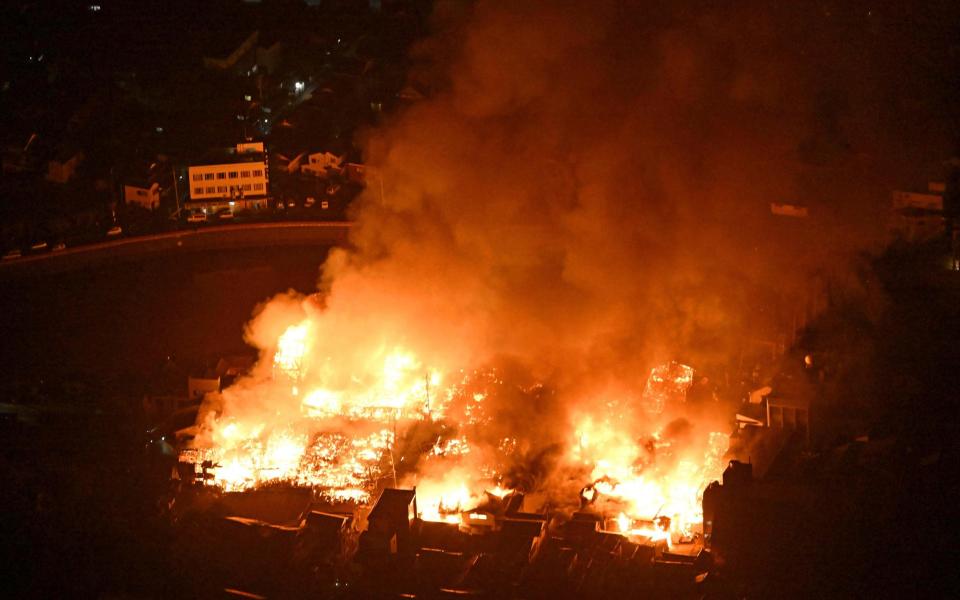
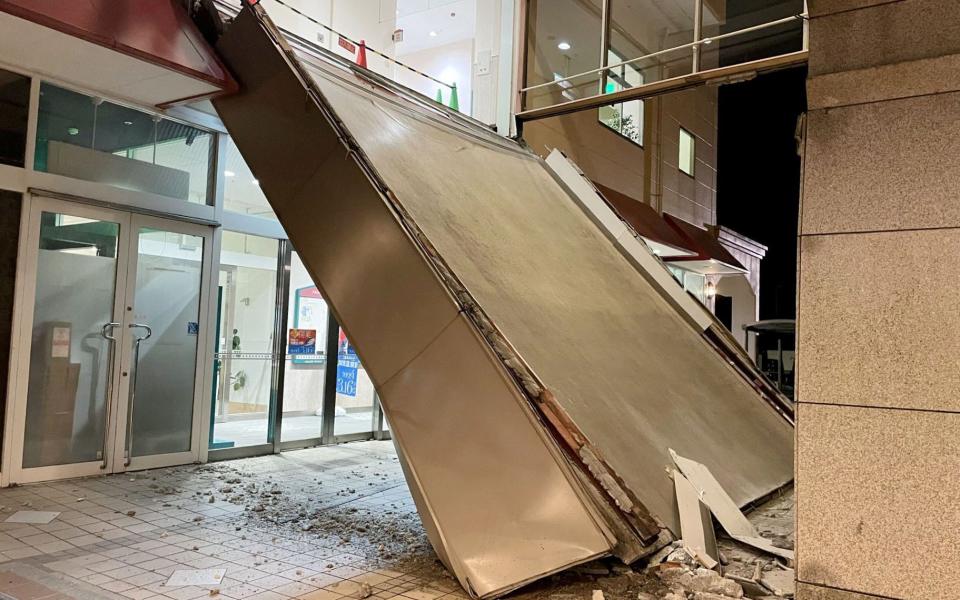
10:57 AM GMT
Watch: Tsunami hits after series of powerful earthquakes
10:42 AM GMT
North Korea issues tsunami warning
North Korea has joined South Korea, Russia and Japan in issuing a tsunami warning.
It said two metre waves could make landfall on its eastern coast, the South Korean Yonhap news agency reported citing North Korean state radio.
10:40 AM GMT
First waves hit South Korea
The first tsunami waves have hit South Korea’s east coast at a height of 45cm, the country’s meteorological agency has said.
It added that The tsunami can grow after the initial waves and may continue for more than 24 hours.
10:38 AM GMT
Watch: Damage in Uchinada
Major damage to roads has been filmed in the coastal town of Uchinada in the Ishikawa prefecture.
Video: the uploader of this video says they are in the coastal town of Uchinada in Ishikawa, Japan. It looks like the earthquake dealt major damage. pic.twitter.com/k9DGHybWKW
— Jeffrey J. Hall 🇯🇵🇺🇸 (@mrjeffu) January 1, 2024
10:33 AM GMT
Do not be complacent, authorities insist
The Japan Meteorological Agency has warned residents of the affected regions to not be complacent.
“A large tsunami has been observed and there is a risk of severe damage”, it cautioned. “People in coastal areas or along rivers should immediately evacuate to a safe location such as higher ground or an evacuation building.
“Tsunami strike repeatedly. Do not leave your safe area until the warning has been lifted.
“In areas where the shaking was strong, there is an increased risk of house collapses and landslides, so please pay close attention to future seismic activity and rainfall conditions, and take precautions such as not entering dangerous areas unless there are unavoidable circumstances.”
10:19 AM GMT
South Korea province urges citizens to evacuate
South Korea’s Gangwon province has urged residents to evacuate to higher ground and stay away from coastal areas.
The country’s meteorological agency said waves up to 30cm high could reach its eastern shore after the series of earthquakes off Japan’s northern coast.
The city of Samcheok advised residents to move to areas higher than a three-storey building, the South Korean interior ministry said.
10:06 AM GMT
Tsunami warnings issued in Russia's far east
Tsunami warnings have been issued in the far eastern Russian island of Sakhalin and the city of Vladivostok.
Sakhalin’s authorities said the waves’ expected height of 50cm means they “do not pose a life threat to the population” but warned those living on its western coast to be alert.
“Fishermen and everyone who plans to go out to sea, has to urgently come back to shore,” Vladivostok city authorities added on social media.
Sakhalin is an elongated island just north of Japan and Vladivostok is Russia’s main Pacific city.
09:55 AM GMT
Hospitals fill up but no reports of deaths
Hospitals across the affected prefectures are treating people injured in the quake, including a woman in her 80s in Ishikawa who fell and sustained a head injury, Julian Ryall reports.
There are reports that hospital staff are encountering problems reaching hospitals as roads have been damaged.
Some facilities have also had to switch to back-up generators as power has been cut.
Medical staff at a hospital in the city of Wajima are treating patients in a car park as aftershocks continue to shake the area and could collapse the hospital.
There are no reported deaths as things stand.
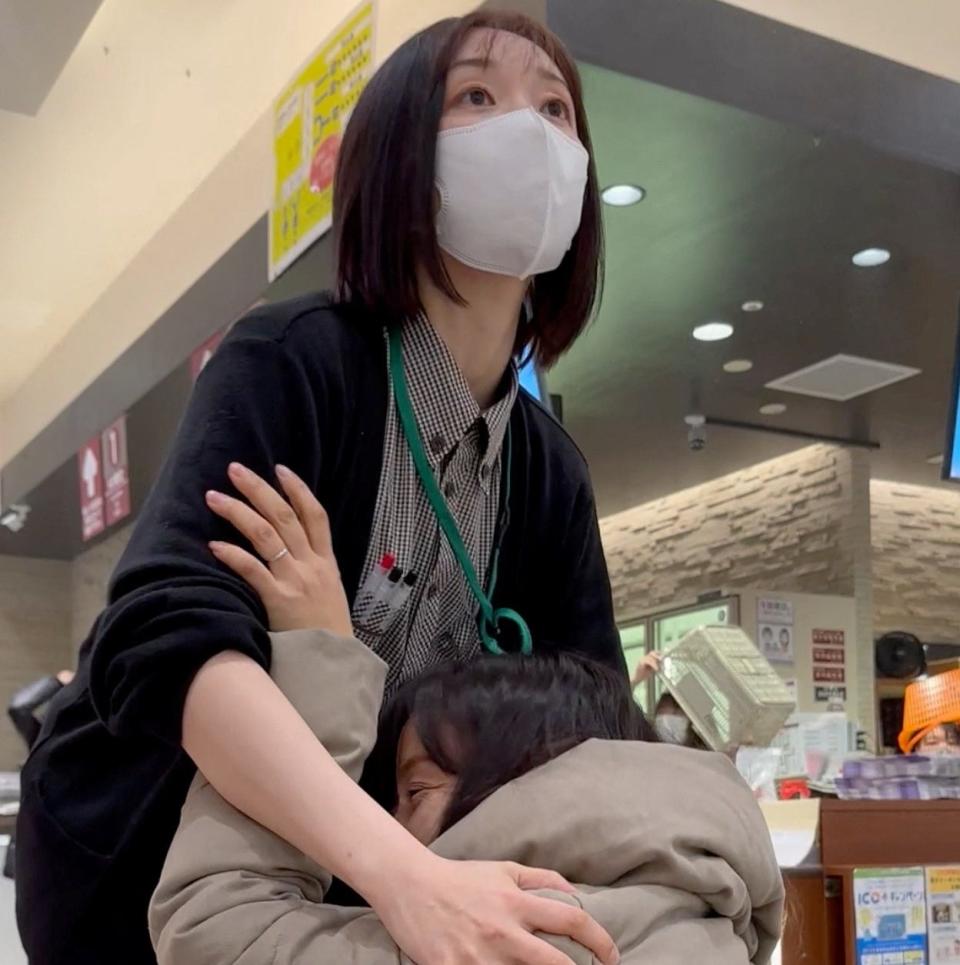
09:52 AM GMT
In pictures: Damaged road and shrine
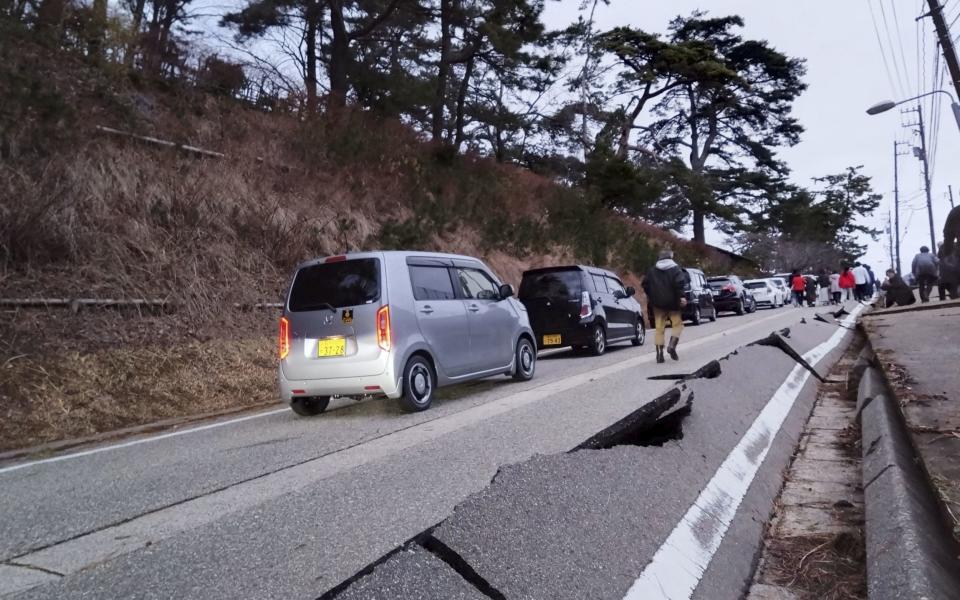
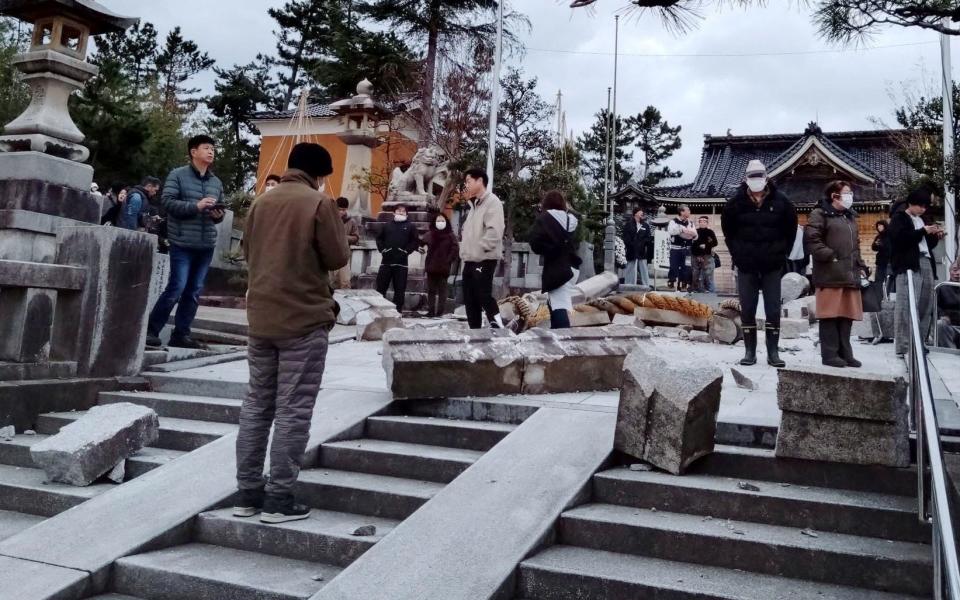
09:49 AM GMT
Flights cancelled and 36,000 without power
Scores of flights have been cancelled after the earthquakes and 36,000 homes were left without power.
Nippon Airways has cancelled 15 flights to airports in the affected regions and Japan Airlines has called off nine.
More than 36,000 households lost power in Ishikawa and Toyama prefectures, utilities provider Hokuriku Electric Power said.
Japan’s Nuclear Regulation Authority said nuclear power plants along the Sea of Japan were unaffected.
Services on local railways, including high-speed bullet train services, have been suspended.
There are also reports of landslides and several roads have been badly damaged and are impassable.
09:46 AM GMT
Earthquake struck at 4pm local time
The main 7.6 magnitude earthquake struck shortly after 4pm local time (7am GMT) just off the northern tip of the Noto peninsula, reports Julian Ryall.
A tsunami alert and orders to evacuate were issued shortly after.
The first tsunami to come ashore were relatively small, from around 11 inches to 45 inches.
But the Japan Meteorological Agency has cautioned that there have already been at least six aftershocks and there is a strong possibility of another tremor of magnitude seven or more in the next 48 hours.
09:43 AM GMT
In pictures: Earthquake damage
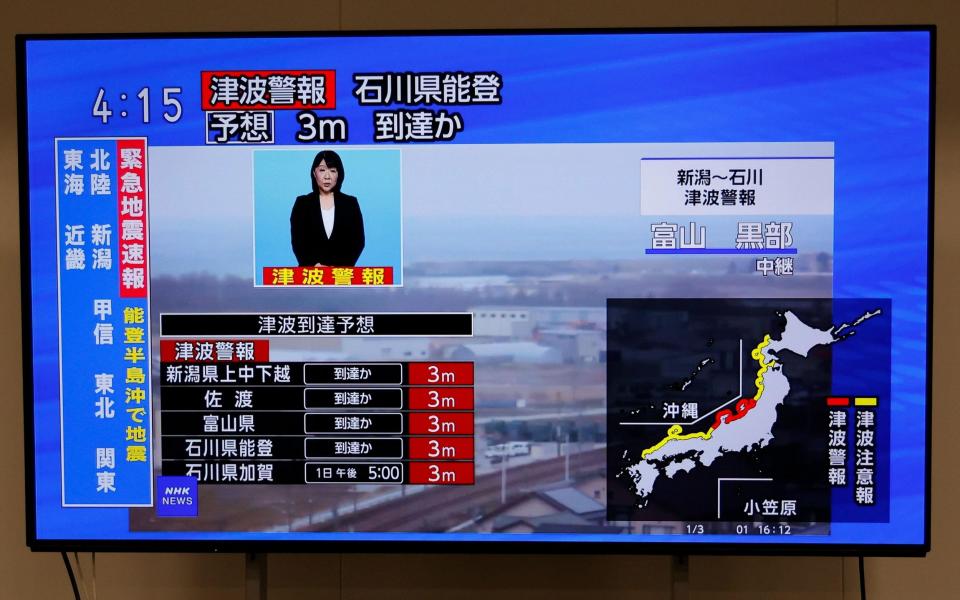
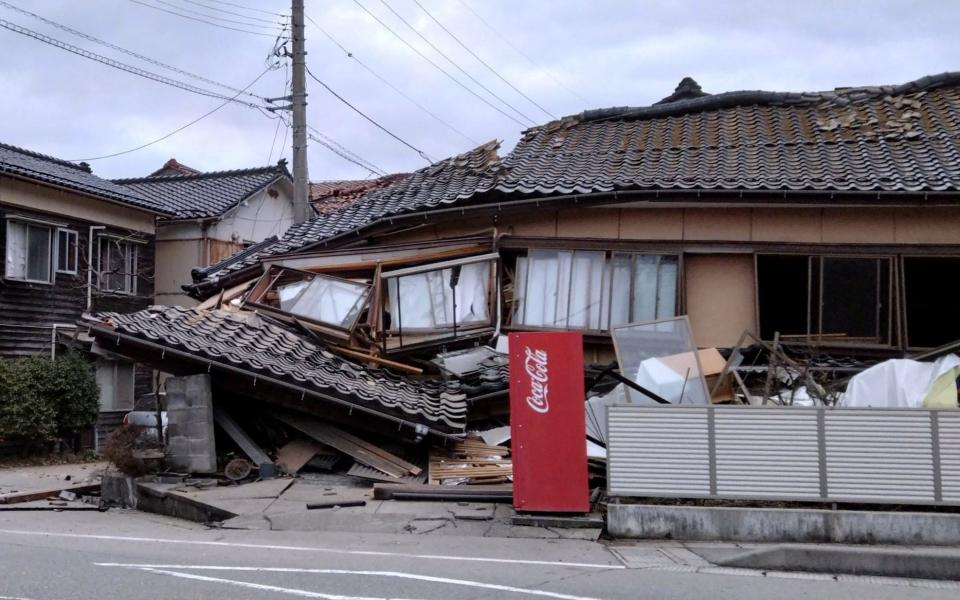
09:41 AM GMT
Roads torn apart and buildings collapse
Residents of seven Japanese regions have been urged to flee an oncoming tsunami after a series of powerful earthquakes struck the east Asian country.
A one-metre tsunami wave has already struck parts of the west coast along the Sea of Japan after a series of more than 20 earthquakes with a magnitude of four or stronger started shortly after 3pm local time (6am GMT).
“A large tsunami has been observed and there is a risk of severe damage,” the Japan Meteorological Agency (JMA) said.
A larger second tsunami is expected and the JMA has warned that waves as high as five metres could strike Ishikawa, one of the affected regions.
Tsunami warnings are in place for the entire length of Japan’s northern coast, running some 1,650 miles from Wakkanai in the far north of Hokkaido to Kyushu in the south.
Warnings have also been issued in Russia’s far eastern island of Sakhalin and city of Vladivostok, as well as South Korea’s Gangwon province. The tsunami waves there are not expected to be large enough to endanger life.
People living in coastal areas of seven Japanese prefectures were instructed to evacuate to higher ground or to seek refuge on higher floors of sturdy buildings.
Fumio Kishida, Japan’s prime minister, has urged authorities to prioritise “human life above all else” and “spare no effort in our emergency disaster responses”.
Tremors shook buildings in Tokyo and buildings in Ishikawa were shown collapsing in the quake as roads in the city of Wajima were torn apart.
Ishikawa Prefecture, the worst-affected region, is a relatively rural part of Japan with a total population of 1.1 million.
Beyond the historic city of Kanazawa, the prefectural capital, coastal communities are typically small and rely on fishing and tourism.

